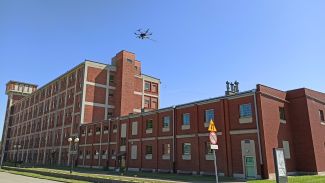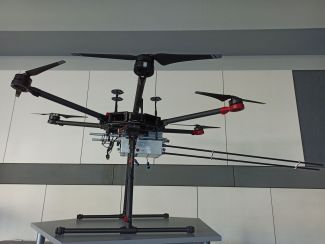You are currently Head of the Institute of Environmental Engineering and Building Installations, where did the idea come from to purchase a specialist drone and conduct air pollution research in this way?
Knowledge of the magnitude and extent of environmental pollution is nowadays essential for functioning in any environment where humans live or reside. Without the analysis of changes in the state of air pollution, it is not possible to carry out full and comprehensive appropriate actions aimed at improving the environment.
Therefore, in order to ensure reliability of the existing measurements of pollution and to extend their scope as well as to develop particular maps for selected locations in the agglomeration of Lodz, I decided to deal with this
subject. I configured and then acquired a mobile measuring and sampling apparatus, unique in Poland, equipped with numerous pollution sensors and designed to be carried by remotely controlled flying devices.
The purchase of two large professional drones, i.e., "unmanned aerial vehicles", was made possible thanks to co-financing of around 80% from the Provincial Environmental Protection and Water Management Fund in Lodz. This has made it possible to monitor air pollution in various locations of key importance to our agglomeration, including the campuses of Lodz University of Technology.
Where specifically did you analyse the state of the air and what did you study?
I have carried out analyses of air pollution levels both inside and outside selected buildings, e.g., for the building of the Institute of Architecture and Urban Planning, the building of the Centre of Papermaking and Printing, or around the building of the Lodz University of Technology Library. And also, in the areas which may be affected by the Lodz EC-3 and EC-4 combined heat and power plants (areas of housing estates) and the largest transport routes (areas of major street crossroads).
Such a large area analysed and at various measurement heights - from the ground level to +50 m upwards - made it possible to work out spatial distribution of concentrations of selected pollutants, in particular particulate matter: PM10 - associated with the processes of combustion of solid and liquid products, PM2.5 - the most harmful atmospheric pollutants for humans, PM1- the smallest and super harmful, the source of which are poor quality fuels, and the following gases: VOC - volatile organic compounds, H2S - sulphuric acid, SO2- sulphur dioxide/dioxide and NO2- nitrogen dioxide/dioxide.
The Lodz University of Technology campus is very green. What kind of air do we breathe? What does the research show?
A detailed analysis of the aerosanitary condition in relation to the height above ground level shows significant differences in the concentration of particular pollutants at different heights. Research has also confirmed the fact that in the case of gaseous pollutants heavier than air, the phenomenon of their accumulation close to the ground surface prevails. As regards dust pollutants, their concentrations were significantly influenced by the roughness of the terrain, local air turbulences and the ability to ventilate the given area.
As a result of conducted analyses, we have gained knowledge about critical locations on our campus from the point of view of air quality. This information may be useful, in the future, to improve the infrastructure of the Technical University of Lodz. They will allow us to introduce corrections in land use, which can be an additional "brick" to improve air quality.
Of course, we also examined other locations, e.g., those in close proximity to emitters such as traffic routes and combined heat and power plants. On this basis, it is possible to state what is the impact of motor transport on emission of pollution or what may cause increased transport in the so-called street canyons. In the case of combined heat and power plants, it was clearly confirmed that they have no noticeable impact on the surrounding area but affect more distant areas through so-called high emissions.
In the film you prepared to summarise the project "TUL in winter from a drone's view - Analysis of air quality", you can see places of high concentration of pollution?
Yes, and these locations are particularly important for direct users of individual rooms in the buildings concerned. Because the state of indoor air quality is affected by the level of pollutants from outdoor air.
As a result, indoor air quality is affected by the direction and speed of the wind outside the building in question. Thanks to our analyses, it has been determined that gaseous pollutants penetrate into a building to a greater extent than particulate pollutants. This is important to know because, at present, much of the emphasis is placed on reporting only particulate matter concentrations, while gaseous pollutants, which are more dangerous to human health, are largely ignored.
There has been a lot of talk in recent years about air pollution and reducing its emissions. Why is the research conducted in the project so important?
The quality of air in the Lodz agglomeration and in other regions of Poland depends on the volume of pollutant emissions, the intensity and type of physical and chemical transformations taking place in the atmosphere. This is particularly important because increased levels of pollution are mainly caused by low emission, which consists mainly of motor transport and the household and municipal sector, including individual heating. At the same time, a high level of air pollution in cities is also caused by the complete or partial development of pre-existing "urban ventilation corridors". - strips of space or greenery - enabling the exchange of air.
As a result, compact and tall buildings cause an accumulation of harmful substances in the central areas of cities. In addition, since we cannot create natural protective barriers that would stop moving masses of polluted air, they may be overlapped by pollutants that have "arrived" from outside the area in question. This is why it is becoming so important and necessary to monitor and analyse the impact of individual pollutants not only on a global scale, but also on a national and local scale. In this way, it will be possible to implement countermeasures which will reduce or "perhaps" even eliminate individual problems associated with the surrounding air quality.
Are you satisfied with the results?
Thanks to the project, knowledge about the scope and levels of air pollution has been expanded. Pollution maps have been drawn up for selected locations, and this may help define the sources of problems and become helpful in preparing air quality improvement plans. I believe that this information may be useful not only to relevant state authorities, but also to residents of the Lodz agglomeration.
Do you intend to continue your research?
Despite the official end of the project at the end of December 2020, measurements and research are still being carried out to further verify the state of air quality, depending on the type and density of buildings, aerosanitary and meteorological conditions, type of pollution sources and distance from individual emitters, including transport routes. It can be said that the research project has moved on to the "second stage", which should include more locations or objects. This stage is currently financed entirely from the own funds of the Institute of Environmental Engineering and Building Installations of the Faculty of Civil Engineering, Architecture and Environmental Engineering at TUL.
The research project entitled: "Analiza przestrzenna zmian stanu zanieczyszczenia powietrza w aglomeracji łódzkiej" [Spatial analysis of changes in the state of air pollution in the Lodz agglomeration] was carried out in 2019-2020. It was co-financed in about 80% from the Provincial Environmental Protection and Water Management Fund in Lodz, and in 20% from own funds of the Institute of Environmental Engineering and Building Installations at Lodz University of Technology.
Interviewed by Małgorzata Trocha


